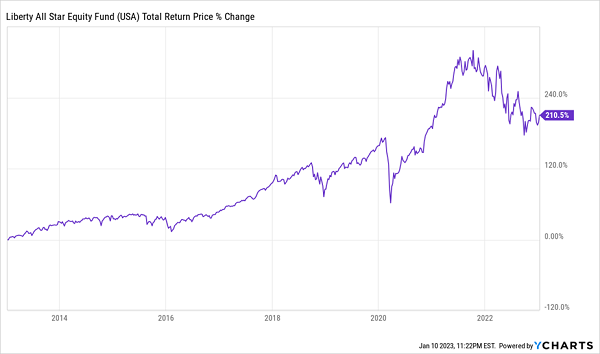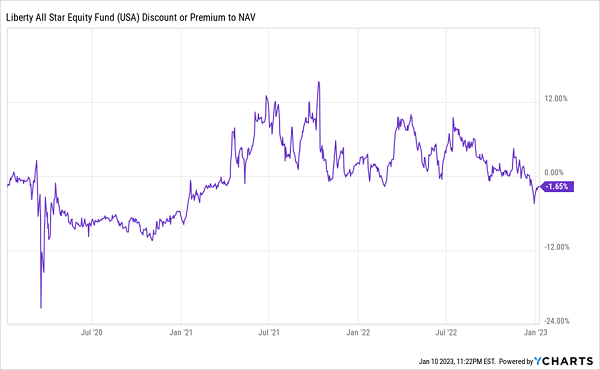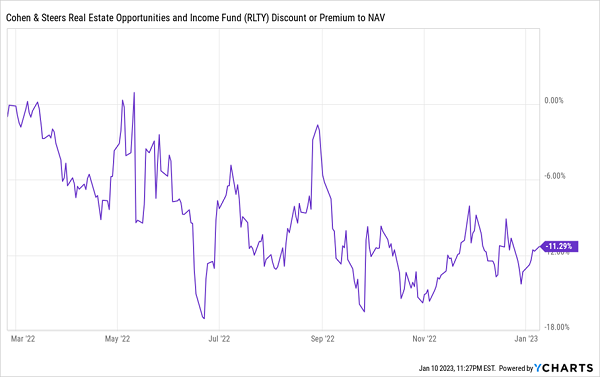Today we’re going to build ourselves a portfolio that hands us a 10.5% yield. And we’re going to do it with just three funds.
The appeal of a 10.5% payout is tough to deny: when you’re getting that much of your investment back every year in dividends, you’ll recoup the whole thing in less than 10 years. Everything else is gravy!
What’s more, two of the three funds below—all of which are closed-end funds (CEFs)—pay dividends monthly, so we’re getting our payouts in line with our bills. That’s unheard-of in the world of vanilla stocks. Almost all of them make us wait three long months for our next payout.
To get started, we only need three things:
- A brokerage account. Just about any account will do, as all the major firms support the CEFs I’m about to show you.
- Savings—but much less than you think. You’ll be amazed at how little money you need to build our 10% income stream. With a yield that size, $500K might be enough for you to retire on dividends alone, depending on your lifestyle.
- About 10 minutes. What I’m about to show you is as easy as buying any stock and holding it over the long haul.
Now let’s talk tickers.
CEF Pick No. 1: A 13%-Yielding Bond Fund From the Best Managers in the Business
Let’s start with a fund from PIMCO, a management firm with a strong reputation and a sterling record, having been co-founded by the “Bond King” himself, Bill Gross, in 1971. The company’s hold on CEF investors’ imaginations is so powerful that its funds typically trade at premiums to net asset value (NAV, or the value of the investments in a CEF’s portfolio).
The PIMCO Dynamic Income Fund (PDI), a 13.3%-yielder with a 10.3% premium, is no different.
We always demand a discount when we buy CEFs, but we can make an exception for PDI because it almost never trades at one. In fact, its current premium is right around its five-year average, so we can say PDI is fairly valued. And we’ll happily pay what the fund is worth for its impressive performance history:
PDI’s Long-Term Profits

PDI’s 8% annualized return over the last decade matches that of the S&P 500—a rare feat for a bond fund. Even better, due to the fund’s high yield, investors got all of their last 10 years of returns in cash. That’s much better than the shaky “paper gains” anyone who holds an S&P 500 index fund must live with, in light of the index’s sub-2% yield.
PDI also regularly pays special dividends. These payouts are significantly larger than the fund’s regular dividend, which itself has grown by 25% over the last 10 years.
Put it all together and we’re getting a dividend yielding 13.3% that grows, plus periodic extra payments and we’re buying in at a fair price. That’s a great setup for anyone looking for bond income.
CEF Pick No. 2: Like Owning Your Favorite S&P 500 Stocks—But With a 9.7% Yield
Let’s pivot to stocks with the Liberty All-Star Equity Fund (USA), owner of cornerstone US stocks like Alphabet (GOOGL), Microsoft (MSFT), Dollar General (DG), UnitedHealth Group (UNH) and Visa (V). USA’s strong portfolio has helped it return 12% annualized over the last decade—the kind of long-term return few other funds can boast.
Big Gains Over the Long Haul

USA yields 9.7%, and its payout does fluctuate with its NAV, so this isn’t a fund to hold for predictable monthly income. But that said, this policy allows management to keep cash free for investment without having to announce a dividend cut (and suffer a corresponding drop in the share price). Moreover, management has done a good job of investing its NAV, as you can see in that 12% annualized return.
We’re also nicely “comped” for this dividend policy through the fund’s current (rare) discount. Buying in now gets us in just below USA’s NAV:
USA’s New Year’s Sale Is On

Like PDI, USA usually trades for more than its assets are worth—the reward for the strong performance from USA’s management. That makes its current discount a rare opportunity to buy in at a bargain.
CEF Pick No. 3: A New Fund Trading at a (Temporary) Discount
Finally, let’s go with the Cohen & Steers Real Estate Opportunities and Income Fund (RLTY), which gives us exposure to thousands of properties and hands you an 8.4% dividend that rolls your way every month.
The fund holds mainly large-cap US REITs, such as warehouse landlord Prologis (PLD)—a direct beneficiary of the “onshoring” of American manufacturing—cell-tower landlord American Tower (AMT) and residential landlord Invitation Homes (INVH).
RLTY is a new fund, launched less than a year ago—and therein lies our opportunity: because it’s so new, RLTY trades at a 10.2% discount to NAV. That’s the case even though many of RLTY’s sister funds, which are managed by the same team, trade close to par or at a premium.
A Flashing Contrarian Buy Signal

That’s our signal to buy and patiently wait as RLTY ages, investors take notice of its existence, and real estate begins to recover. Meantime, we’ll collect the fund’s 8.4% dividend, which comes our way monthly.
Warning: If You Pass Up These 9.5% Payers Now, You Could Miss Out on Serious Gains
Of all the CEF indicators to follow, the discount to NAV is the best one in our toolbox. Simply put, if you buy when a discount “window” is wide, you’ll give yourself a superb chance of big gains—in addition to the outsized yields these funds pay!
I’ve got 4 other CEFs on my buy list now that have completely ridiculous discounts indeed. These 4 unsung buys are so cheap that I’m calling for 20%+ price upside from them in the next year, to go along with their outsized 9.5% dividend payouts!
The time to buy them is now. Click here and I’ll give you my full CEF-investing strategy and show you how to download an exclusive Special Report giving you these 4 funds’ names, tickers, yields and my research on each one.
